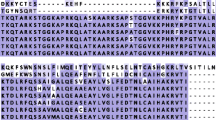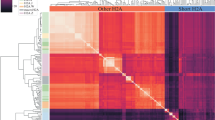Summary
The nucleic acid sequences coding for 23 H3 histone genes from a variety of species have been analyzed using a computer assisted alignment and analysis program. Although these histones are highly conserved within and between highly divergent species, they represent various classes of histones whose patterns of expression are distinctively regulated. Surprisingly, in dendrograms derived from these comparisons, H3 sequences cluster according to their modes of regulation rather than phylogenetically. These clusters are generated from highly distinctive patterns of codon usage within the functional gene classes. We suggest that one factor involved in specifying the differing codon usage patterns between functional classes is a difference in requirements for rapid translation of mRNA. In addition, the data presented here, together with structural and sequence information, suggest a heterodox evolutionary model in which genes related to the intron-bearing, basally expressed H3.3 vertebrate genes are the ancestors of the intronless H3. 1 class of genes of higher eukaryotes. The H3. 1 class must have arisen, therefore, following duplication of a primitive H3.3 gene, but prior to the plant-animal divergence. Implications of the data presented are discussed with regard to functional and evolutionary relationships.
Similar content being viewed by others
References
Abarbanel R, Weineke PR, Mansfield E, Jaffe DA, Brutlag DL (1984) Rapid searches for complex patterns in biological molecules. Nucleic Acids Res 12:263–280
Angerer L, DeLeon D, Cox K, Maxson R, Kedes L, Kaumeyer J, Weinberg E, Angerer R (1985) Simultaneous expression of early and late histone messenger RNAs in individual cells during development of the sea urchin embryo. Dev Biol 112:157–166
Bains W (1986) MULTAN: a program to align multiple DNA sequences. Nucleic Acids Res 14:159–177
Bennetzen JL, Hall BD (1982) Codon selection in yeast. J Biol Chem 257:3018–3025
Birchmeier C, Schumperli D, Sconzo G, Birnstiel ML (1984) 3′ Editing of mRNAs: sequence requirements and involvement of a 60-nucleotide RNA in maturation of histone mRNA precursors. Proc Natl Acad Sci USA 81:1057–1061
Brandt WF, Strickland WN, van Holt C (1974) FEBS Lett 40:349–352
Childs G, Nocente-McGrath C, Lieber T, Holt C, Knowles J (1982) Sea urchin late stage histone H3 and H4 genes: characterization and mapping of a clustered but nontandemly linked multigene family. Cell 31:383–393
Darnell J (1982) Varieties in the level of gene control in eukaryotic cells. Nature 297:365–371
Engel J, Gunning P, Kedes L (1982) Human cytoplasmic actin proteins are encoded by a multigene family. Mol Cell Biol 2:674–684
Farris JS (1972) Estimating phylogenetic trees from distance matrices. Am Nat 106:645–668
Gouy M, Gautier C (1982) Codon usage in bacteria: correlation with gene expressivity. Nucleic Acids Res 10:7055–7074
Grantham R, Gautier C, Gouy M, Mercier R, Pave A (1980) Codon catalog usage and the genome hypothesis. Nucleic Acids Res 8:r49-r62
Grosjean H, Fiers W (1982) Preferential codon usage in prokaryotic genes: the optimal codon-anticodon interaction energy and the selective codon usage in efficiently expressed genes. Gene 18:199–209
Hentschel C, Birnstiel M (1981) The organization and expression of histone gene families. Cell 25:301–313
Ikemura T (1985) Codon usage and tRNA content in unicellular and multicellular organisms. Mol Biol Evol 2:13–34
Ikemura T, Ozeki M (1982) Codon usage and tRNA contents: specific codon choice patterns in reference to the isoacceptor contents. Cold Spring Harbor Symp Quant Biol 47:1087–1097
Isenberg I (1979) Histones. Annu Rev Biochem 48:159–191
Jukes TH, King JL (1979) Evolutionary nucleotide replacement in DNA. Nature 281:605–606
Kedes LH (1979) Histone genes and histone messengers. Annu Rev Biochem 48:837–870
Kimura T (1981) Estimation of evolutionary distance between homologous nucleotide sequences. Proc Natl Acad Sci USA 78:454–458
Krieg PA, Melton DA (1984) Formation of the 3′ end of histone mRNA by post-transcriptional processing. Nature 308:203–206
Maxson R, Mohun T, Cohn R, Kedes L (1983a) Expression and organization of histone genes. Annu Rev Genet 17:237–277
Maxson R, Mohun T, Kedes L (1983b) Histone genes. In: Maclean N, Gregory S, Flavell R (eds) Eucaryotic genes: their structure, activity and regulation. Butterworths, London, pp 277–298
McClelland M, Ivarie R (1982) Asymmetrical distribution of CpG in an average mammalian gene. Nucleic Acids Res 10:7865–7877
Miyata T, Yasunaga T, Nishida T (1980) Nucleotide sequence divergence and functional constraint in mRNA evolution. Proc Natl Acad Sci USA 77:7328–7332
Moorman AFM, DeBoer PAJ, DeLaff RTM, Destree OHJ (1981) Histone gene fromXenopus laevis: molecular cloning and initial characterization. FEBS Lett 136:45–52
Nudel U, Zakut R, Shani M, Neuman S, Levy Z, Yaffe D (1983) The nucleotide sequence of the rat cytoplasmic b-acti gene. Nucleic Acids Res 11:1759–1771
Old RW, Woodland HR (1984) Histone genes: not so simple after all. Cell 38:624–626
Old RW, Woodland HR, Ballentine JEM, Aldridge TC, Newton CA, Bains WA, Turner PC (1982) Organization and experession of cloned histone gene clusters fromXenopus laevis andXenopus borealis. Nucleic Acids Res 10:7561–7580
Patthy L, Smith EL, Johnson I (1973) The amino acid sequence of the pea embryo histone. J Biol Chem 248:6834–6840
Perler F, Efstratiadis A, LoMedico P, Gilbert W, Kolodner R, Dodgson J (1980) The evolution of genes: the chicken preproinsulin gene. Cell 20:555–566
Samal B, Worcel A (1981) Chromatin structure of the histone genes ofDrosophila melanogaster. Cell 23:401–409
Shpaer E (1985) The secondary structure of mRNA fromE. coli: its possible role in increasing the accuracy of translation. Nucleic Acids Res 13:275–288
Smith MM, Andresson OS (1983) The sequences of yeast H3 and H4 histone genes from two non-allelic gene sets encode identical H3 and H4 proteins. J Mol Biol 169:663–690
Tabata T, Kimiko S, Iwabuchi M (1983) The structureal organization and DNA sequence of wheat H4. Nucleic Acids Res 11:5865–5875
Takahata N (1982) The disappearance of duplicate gene expression. In: Kimura M (ed) Molecular evolution, protein polymorphism and the neutral theory. Japan Science Society Press, Tokyo, pp 169–190
Turner PC, Woodland HR (1982) Histone gene number and organization inXenopus: Xenopus borealis has a homogeneous major cluster. Nucleic Acids Res 11:971–986
Wells D, Kedes L (1985) Novel structure of a human histone cDNA: evidence that basally expressed histone genes have intervening sequences and encode polyadenylated mRNA. Proc Natl Acad Sci USA 82:2834–2839
Woudt LP, Pastink A, Kemper AS, Jansen AEM, Mager WH, Planta RJ (1983) The genes coding for histones H3 and H4 inNeurospora crassa. Nucleic Acids Res 11:5347–5360
Wu RS, Tsai S, Bonner WM (1983) Changes in histone H3 composition and synthesis pattern during lymphocyte activation. Biochemistry 22:3868–3872
Author information
Authors and Affiliations
Rights and permissions
About this article
Cite this article
Wells, D., Bains, W. & Kedes, L. Codon usage in histone gene families of higher eukaryotes reflects functional rather than phylogenetic relationships. J Mol Evol 23, 224–241 (1986). https://doi.org/10.1007/BF02115579
Received:
Revised:
Issue Date:
DOI: https://doi.org/10.1007/BF02115579




